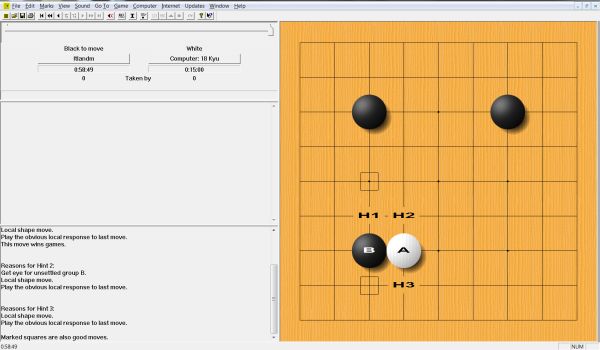
“Play the obvious local response to last move” – which of these three will it be?
As recently mentioned, I imagined an alternative timeline starting around the end of October 2009, in which I devoted substantially more time and attention to mastering Go (igo / baduk / weiqi), the classical Asian board game. One important factor was the computer program “The Many Faces of Go”, a Windows program created by David Fotland at www.smart-games.com. The program doubles as either a tutor or an opponent, depending on your needs.
Daydreaming with dice is serious business, so naturally I have gone and bought the program so that I could verify for myself whether it would have the necessary impact on my alternate timeline. (That, and mostly I was curious, having read good things about it, except the price.) My estimate is that yes, it is a good alternative for people who don’t have access to a Go club or other human players. It set me back $90, which is insignificant here in Norway but may be a problem in less developed countries.
You can download the game for free, but in that case it simply plays as an opponent with strength of 18 kyu. If you shell out the $90, you get a bunch of other features, and variable opponent strength from newbie up to early dan levels.
In addition to being one of the strongest artificial intelligence Go players, the game is a versatile tutor. If you know nothing about Go, it will even teach you the basic rules. (But if you know nothing about Go, I am not sure if I would recommend you pay $90 up front…)
The program has a database of thousands of commented games, both by professionals and amateurs, so there is a good chance that you will find something interesting there. You can step through these and read the comments. However, the Internet is overflowing with such commented games which you can read with a free kifu reader (kifu = game record in Go). In fact, many amateur games in this database is from the Go Teaching Ladder, which I am pretty sure I have praised before. It is nice that this is included in The Many Faces of Go, but this is not where the program justifies its price.
There are also databases of fuseki (opening patterns) and joseki (corner patterns), which more advanced Go players may want to study. These are also things that you can scrounge together for free with a little work, but integrated into the same package.
Where The Many Faces of Go really shines, in my opinion, is as an interactive tutor. You estimate your strength (starting at 30 kyu for a brand newbie) and the game gives you the suitable number of handicap stones and adjusts its playing strength. Then, as you play against the program, you can ask it to explain its moves, why it does what it does. You can either ask about individual moves, or turn on the function so that it explains each move as the program makes it. The explanations are very general, but give a good idea of things to think of. If you keep this commentary running, you just might get into the habit of thinking that way yourself. It also marks other spots of interest on the board that it considered but did not play, so you can learn from that as well, although it does not explain why it did not pick any of them.
Perhaps even better, you can at any time ask MFoG to give you a hint. It will then list three alternative moves in order, with the reasons for making each of them. It is then up to you to choose which of them to play, or perhaps none of them. Again, it marks other spots of interest on the board as well, if you want to branch out further.
Of course, if all you do is ask for the next move and click there, you are not quite playing Go. It may not be a bad idea for a beginner, though! In the anime Hikaru no Go, which is written in close collaboration with an expert, the main character learns Go by being the hands of an expert player. (In the anime the expert player happens to be a ghost, so having someone place the stones for him is pretty important, and Hikaru is the only person who can see him.) Sai, the 1000 year old Go player, reads out the coordinates of each stone Hikaru should place on the board, but he also adds a word that describes the type of move it is. Japanese have many such words that describe the function of a move. It is not quite as detailed as the explanations in MFoG, but it teaches the young boy some aspects of the game. In one memorable scene, Sai tells him: “Don’t just place the stones, try to feel the flow of them.” This is good advice for anyone using Many Faces of Go as well.
In the anime, Hikaru became so good that he eventually did not need the ghost anymore. Hopefully the same will happen with the “ghost in the machine” here. But with someone as anti-talented at Go as me, that could easily take many years. I am not sure I will spend years of my real life (such as it is) playing Go. But for those who have that intention, this might be a good way to get started.
